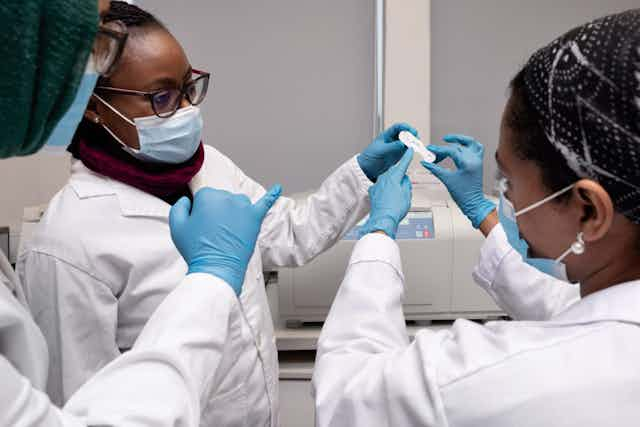In healthcare systems where resources are limited, it’s common for some conditions to be overlooked or misdiagnosed. This is especially true if the patient doesn’t have obvious symptoms, and if tests are unaffordable. Sometimes, healthcare providers look at a group of symptoms to reach a likely diagnosis. This so-called syndromic management is less accurate than laboratory-based diagnostics.
A good example of syndromic management is the World Health Organisation’s guidelines for managing sexually transmitted infections and bacterial vaginosis (a disturbance in healthy vaginal bacterial communities). These conditions are frequently missed using this approach. They may also go untreated because women don’t always have clinical symptoms. Untreated infections and bacterial imbalances increase the risk of HIV infection in women and the risk of pregnancy complications like preterm birth.
In sub-Saharan Africa, women and adolescent girls are at very high risk of HIV and preterm birth.
In 2010, we discovered that South African women with asymptomatic sexually transmitted infections and bacterial vaginosis had levels of vaginal inflammation that were similar to women with clinically evident symptoms. This could provide ideal conditions for HIV infection. Inflammation disrupts the epithelial barrier – the thin lining of the body – allowing the HI virus to enter the tissue and replicate.
Most bacterial sexually transmitted infections are curable with antibiotics. But diagnostic tests are too expensive to use in resource poor settings. As a result, women in these areas are only treated if they have symptoms. Most women with these infections don’t have symptoms, though, and still have high levels of inflammation and risk of HIV infection.
We decided to find a better way to test for asymptomatic vaginal infections in women in resource poor settings. The result was the invention of the Genital Inflammation Test or GIFT.
First we screened inflammatory proteins in vaginal samples from women from different regions in sub-Saharan Africa. This allowed us to identify which proteins are an accurate sign, or biomarker, of sexually transmitted infections and bacterial vaginosis. The test looks for these proteins.
Our prototype is a lateral flow test, similar to an off-the-shelf pregnancy test. This was chosen because of its low technology and low cost potential. And it can be done quickly and easily at the point of primary care or as part of home care.

The next generation of the device and regulatory approval of the test is already in the pipeline.
Next steps
Now, the project will focus on refining the prototype.
This important step is about to be realised with a new [grant] from the European and Developing Countries Clinical Trials Partnership. This is a public-public partnership which aims to accelerate the development of clinical interventions for HIV/AIDS, tuberculosis and malaria.
The new funding has given us the opportunity to form new and strengthen existing partnerships with African and international organisations. The study team includes researchers at the Burnet Institute, the Desmond Tutu Health Foundation, the Organization for Public Health Interventions and Development, the Institut Pasteur de Madagascar, Institut Pasteur, Hitotsubashi University, London School of Hygiene and Tropical Medicine, and Utrecht University Medical Centre.
In addition to manufacturing the next generation of the device, the funding will be used to conduct clinical trials. We will test the field performance of the device for women in South Africa, Zimbabwe and Madagascar.
We’ll also develop the plan for using it in the existing clinical framework for managing vaginal infections and bacterial vaginosis.
In addition, the funding will contribute to training young scientists in sub-Saharan Africa. It will build critical research capacity and expertise.
This strategic funding gets the device one step closer to national and EU registration of the device.
Looking forward
The next step is to look for partners to assist in the rollout of the lateral flow device, including funders, implementation partners and healthcare professionals. There is also an opportunity to use local diagnostic manufacturers and component suppliers to meet the demand and export the product.
Treatment based on symptoms has been a poor tool in management of vaginal infections and bacterial vaginosis in women. The goal is to have an effective, affordable and low tech tool to detect cases at the point of care. In turn, this could have a major impact on reproductive health and HIV risk in women in African countries.

